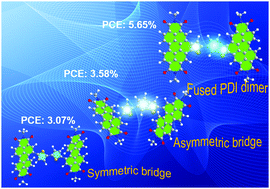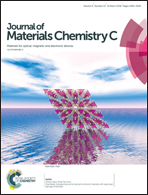A perylenediimide dimer containing an asymmetric π-bridge and its fused derivative for fullerene-free organic solar cells†
Abstract
Recent success stories of perylenediimide (PDI) derivatives have stimulated tremendous interest. They are under intense investigation to replace fullerenes as the electron acceptor in organic solar cells. In priciple, the strategy of linking two PDI rings to get a PDI dimer could efficiently suppress the excessive π–π stacking tendency and avoid the large phase separation. However, almost all the reported PDI dimers are symmetric structures, asymmetric building blocks as the π-bridge are rare. Here, we used an asymmetric 6-(thiophen-2-yl)benzo[b]thiophene (T-BTh) group as the π-bridge to connect two PDI units, affording compound A101. Through annulation of A101, we further synthesized the fused PDI dimer of A102. Fused A102 shows increased effective π-conjugation and reduced twist angle between the two PDI subplanes, resulting in a favorable morphology and strong π–π stacking. As a result, A102 showed an improved power conversion efficiency of 5.65% in comparison with that of A101 (3.57%), due to the higher open-circuit voltage (VOC) and short-circuit current (JSC). The higher VOC results from the higher lowest unoccupied molecular orbital (LUMO) level of A102 and the higher JSC can be explained on the basis of better charge carrier mobilities. These results provide important information and open a new way to design novel PDI-based or other small molecular electron acceptors.



 Please wait while we load your content...
Please wait while we load your content...